What We’re Reading: September 15th
Thanks for all the contributed paper summaries! If you’d like to summarize a paper for this series, contact Mary Williams ([email protected]).
Special Issue of Current Biology “The Making of a Plant”
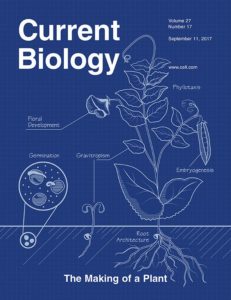 Browsing the table of contents of the “The Making of a Plant” special issue of Current Biology feels like a birthday celebration; there are so many exciting goodies it’s hard to know which to open first. The issue consists of well-written and well-illustrated short reviews (and Quick Guides and Primers, as well as a Feature and an Essay) on topics ranging from how “paintings and other artefacts over the centuries can give insight into the evolution of wheat” to reviews spanning from the ABC model of floral development, to shoot-root communication, to thigmomorphogenesis, to an editorial on the contributions of Wilhelm Hofmeister to modern studies of plant biology. As much as I enjoy my paperless office, this is one of those highly browseable issues I’d really like to have as a hard copy! Curr. Biol. Vol 27, Issue 17.
Browsing the table of contents of the “The Making of a Plant” special issue of Current Biology feels like a birthday celebration; there are so many exciting goodies it’s hard to know which to open first. The issue consists of well-written and well-illustrated short reviews (and Quick Guides and Primers, as well as a Feature and an Essay) on topics ranging from how “paintings and other artefacts over the centuries can give insight into the evolution of wheat” to reviews spanning from the ABC model of floral development, to shoot-root communication, to thigmomorphogenesis, to an editorial on the contributions of Wilhelm Hofmeister to modern studies of plant biology. As much as I enjoy my paperless office, this is one of those highly browseable issues I’d really like to have as a hard copy! Curr. Biol. Vol 27, Issue 17.
Review: Mechanosensitive ion channels ($)
 Ion channels are proteins that regulate the passage of ions across membranes. Ion channels are regulated in diverse ways – some are calcium-regulated, some are pH sensitive, some are charge sensitive, and some are sensitive to mechanical stimulation i.e., membrane tension. Basu and Haswell review mechanosensitive ion channels in plants, which have been implicated in responses to osmotic pressure, touch, gravity and other forces. Insights from other organisms suggest models for their regulation, such as the “force from lipid” concept, and areas for additional study. A major future challenge is to examine plant mechanosensitive ion channel function in their native contexts. Curr. Opin. Plant Biol. 10.1016/j.pbi.2017.07.002
Ion channels are proteins that regulate the passage of ions across membranes. Ion channels are regulated in diverse ways – some are calcium-regulated, some are pH sensitive, some are charge sensitive, and some are sensitive to mechanical stimulation i.e., membrane tension. Basu and Haswell review mechanosensitive ion channels in plants, which have been implicated in responses to osmotic pressure, touch, gravity and other forces. Insights from other organisms suggest models for their regulation, such as the “force from lipid” concept, and areas for additional study. A major future challenge is to examine plant mechanosensitive ion channel function in their native contexts. Curr. Opin. Plant Biol. 10.1016/j.pbi.2017.07.002
Review. Fine-tuning timing: Natural variation informs the switch to flowering in Arabidopsis thaliana ($)
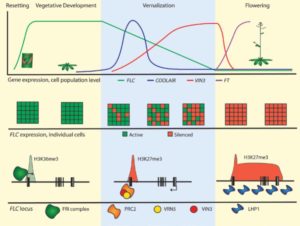 The transition from vegetative growth to a flower-producing reproductive state is highly regulated by environmental cues. The model plant Arabidopsis thaliana has a wide distribution throughout different habitats, so each accession has different adaptations strategies. One of the major factors that varies between accessions is the requirement and response to long periods of cold before flowering (vernalization). In this review, Bloomer and Dean focus on the two flowering repressor genes where the majority of the natural variations have been mapped: FRIGIDA (FRI) and FLOWERING LOCUS C (FLC). They describe how FLC is regulated through plant development, first by upregulation via FRI at the seed stage followed by a gradual down-regulation at the beginning of vernalization mediated by FLC antisense RNA transcripts and later by a switch-off in a cell-by-cell manner due to changes in epigenetic marks across the FLC gene. The authors conclude by observing that many species in the Brassicaceae family (like broccoli, kale, and Brussels sprouts among others) share the involvement of FLC orthologs in vernalization, and that understanding of this gene and its complex regulation has enhanced our ability to manipulate flowering time in these crops. (Summary by Aime Jaskolowski) J. Exp. Bot. 10.1093/jxb/erx270
The transition from vegetative growth to a flower-producing reproductive state is highly regulated by environmental cues. The model plant Arabidopsis thaliana has a wide distribution throughout different habitats, so each accession has different adaptations strategies. One of the major factors that varies between accessions is the requirement and response to long periods of cold before flowering (vernalization). In this review, Bloomer and Dean focus on the two flowering repressor genes where the majority of the natural variations have been mapped: FRIGIDA (FRI) and FLOWERING LOCUS C (FLC). They describe how FLC is regulated through plant development, first by upregulation via FRI at the seed stage followed by a gradual down-regulation at the beginning of vernalization mediated by FLC antisense RNA transcripts and later by a switch-off in a cell-by-cell manner due to changes in epigenetic marks across the FLC gene. The authors conclude by observing that many species in the Brassicaceae family (like broccoli, kale, and Brussels sprouts among others) share the involvement of FLC orthologs in vernalization, and that understanding of this gene and its complex regulation has enhanced our ability to manipulate flowering time in these crops. (Summary by Aime Jaskolowski) J. Exp. Bot. 10.1093/jxb/erx270
A plant protein structure from the MATE family, an important family of transporters ($)
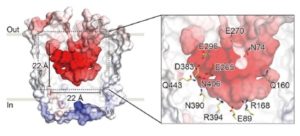 The MATE (multidrug and toxic compound extrusion) family is found in all three domains of life. Proteins in this family are secondary transporters, functioning as sodium or proton/organic cation antiporters. This family has diverse functions in plants, including vacuolar sequestration of alkaloids, regulation of local auxin biosynthesis, iron uptake and aluminum tolerance. While the crystal structures of MATE proteins from five prokaryotes have been published, Tanaka et al. have described the first plant MATE structure. This MATE (CasMATE), from Camelina sativa, was found to have two sets of six transmembrane alpha-helices and was crystallized in an outward-facing orientation. While CasMATE has a similar cation binding pocket as a known bacterial MATE, there were many differences. This CasMATE structure is an example of the binding pocket structure of plant MATE proteins, providing insight into substrate binding and specificity. (Summary by Julia Miller) Structure 10.1016/j.str.2017.07.009
The MATE (multidrug and toxic compound extrusion) family is found in all three domains of life. Proteins in this family are secondary transporters, functioning as sodium or proton/organic cation antiporters. This family has diverse functions in plants, including vacuolar sequestration of alkaloids, regulation of local auxin biosynthesis, iron uptake and aluminum tolerance. While the crystal structures of MATE proteins from five prokaryotes have been published, Tanaka et al. have described the first plant MATE structure. This MATE (CasMATE), from Camelina sativa, was found to have two sets of six transmembrane alpha-helices and was crystallized in an outward-facing orientation. While CasMATE has a similar cation binding pocket as a known bacterial MATE, there were many differences. This CasMATE structure is an example of the binding pocket structure of plant MATE proteins, providing insight into substrate binding and specificity. (Summary by Julia Miller) Structure 10.1016/j.str.2017.07.009
Silencing phosphoenolpyruvate carboxylase phosphorylation in a CAM plant
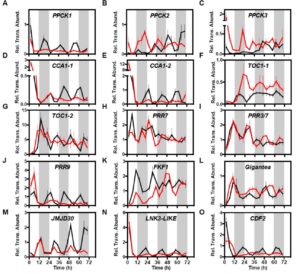 Many plants living in arid environments conserve water by taking up CO2 at night through the action of the enzyme phosphoenolpyruvate carboxylase (PPC); this process, which is widespread in the Crassulaceae family, is known as Crassulacean acid metabolism (CAM). The nocturnal activity of PPC is regulated post-transcriptionally through its phosphorylation by PPC kinase (PPCK). Boxall et al. investigated the effect of using RNA interference to decrease expression of PPCK in the CAM plant Kalanchoë fedtschenkoi. As expected, they found that the PPCK knock-down plants showed less CO2 fixation in the dark and greater sensitivity to drought. They also found that several genes encoding components of the circadian clock lost their circadian periodicity in the knock-down mutants, suggesting that, “perturbing the only known link between CAM and the circadian clock feeds back to perturb the central circadian clock itself.” Plant Cell 10.1105/tpc.17.00301
Many plants living in arid environments conserve water by taking up CO2 at night through the action of the enzyme phosphoenolpyruvate carboxylase (PPC); this process, which is widespread in the Crassulaceae family, is known as Crassulacean acid metabolism (CAM). The nocturnal activity of PPC is regulated post-transcriptionally through its phosphorylation by PPC kinase (PPCK). Boxall et al. investigated the effect of using RNA interference to decrease expression of PPCK in the CAM plant Kalanchoë fedtschenkoi. As expected, they found that the PPCK knock-down plants showed less CO2 fixation in the dark and greater sensitivity to drought. They also found that several genes encoding components of the circadian clock lost their circadian periodicity in the knock-down mutants, suggesting that, “perturbing the only known link between CAM and the circadian clock feeds back to perturb the central circadian clock itself.” Plant Cell 10.1105/tpc.17.00301
Identification of a methyltransferase catalyzing the final step of methyl anthranilate synthesis in cultivated strawberry
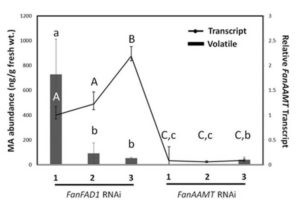 Methyl anthranilate (MA) is a volatile chemical that contributes to the aroma of strawberry (Fragaria spp.), but several modern varieties do not produce this chemical. Pillet et al. tried to identify the biosynthetic pathway of MA. They compared transcriptomes between MA-producing and non-producing varieties and identified five candidate genes, one of which was predicted to encode a methyltransferase. Using an RNAi approach in agroinfiltrated strawberry fruit, they showed that suppressing expression of this gene (which they named FanAAMT for ANTHRANILIC ACID METHYL TRANSFERASE) leads to decreased MA accumulation. E. coli cultures expressing the FanAAMT transcript and provided with antranilic acid produce MA, again supporting the role of FanAAMT in MA production. This study will help in efforts to introduce MA production into modern strawberry varieties. (Summary by Arif Ashraf) BMC Plant Biol. 10.1186/s12870-017-1088-1
Methyl anthranilate (MA) is a volatile chemical that contributes to the aroma of strawberry (Fragaria spp.), but several modern varieties do not produce this chemical. Pillet et al. tried to identify the biosynthetic pathway of MA. They compared transcriptomes between MA-producing and non-producing varieties and identified five candidate genes, one of which was predicted to encode a methyltransferase. Using an RNAi approach in agroinfiltrated strawberry fruit, they showed that suppressing expression of this gene (which they named FanAAMT for ANTHRANILIC ACID METHYL TRANSFERASE) leads to decreased MA accumulation. E. coli cultures expressing the FanAAMT transcript and provided with antranilic acid produce MA, again supporting the role of FanAAMT in MA production. This study will help in efforts to introduce MA production into modern strawberry varieties. (Summary by Arif Ashraf) BMC Plant Biol. 10.1186/s12870-017-1088-1
Frequent paramutation-like features of natural epialleles in tomato
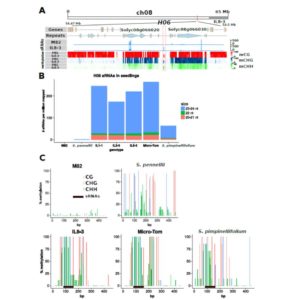 Paramutation is a natural epigenetic process that occurs in plants and animals that is associated with methylation-mediated gene silencing. The curious thing about a paramutated allele is than it can transfer its silenced state to its homologous and active allele. This freshly paramutated allele then becomes silenced and acquires the ability to silence other active alleles in subsequent generations, so that inheritance patterns are non-Mendelian. Gouil and Baulcombe worked with hybrid lines between Solanum pennellii (the wild relative of tomato) and Solanum lycopersicum cv. M82 (a domesticated cultivar of tomato). They studied a particular locus that they characterized as paramutated. The authors propose a correlation between high levels of production of small RNAs and a rapid transfer of the epigenetic marks. The authors conclude that, “paramutation-like epigenetic interactions are common for natural epialleles in tomato, but vary in timing and penetrance.” This finding is particularly interesting due to the wide-scale practice of making hybrids to enhance agronomic characteristics. (Summary by Aime Jaskolowski) bioRxiv 10.1101/177972
Paramutation is a natural epigenetic process that occurs in plants and animals that is associated with methylation-mediated gene silencing. The curious thing about a paramutated allele is than it can transfer its silenced state to its homologous and active allele. This freshly paramutated allele then becomes silenced and acquires the ability to silence other active alleles in subsequent generations, so that inheritance patterns are non-Mendelian. Gouil and Baulcombe worked with hybrid lines between Solanum pennellii (the wild relative of tomato) and Solanum lycopersicum cv. M82 (a domesticated cultivar of tomato). They studied a particular locus that they characterized as paramutated. The authors propose a correlation between high levels of production of small RNAs and a rapid transfer of the epigenetic marks. The authors conclude that, “paramutation-like epigenetic interactions are common for natural epialleles in tomato, but vary in timing and penetrance.” This finding is particularly interesting due to the wide-scale practice of making hybrids to enhance agronomic characteristics. (Summary by Aime Jaskolowski) bioRxiv 10.1101/177972
EIN2 mediates direct regulation of histone acetylation in the ethylene response
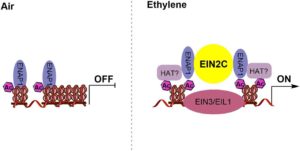 Perception of the phytohormone ethylene results in the cleavage of EIN2 and translocation to the nucleus of its C-terminal end, EIN2-C. Zhang et al. showed that EIN2-C is essential for chromatin modification that allows EIN3, the main ethylene signaling transcription factor, to transcriptionally regulate its target genes. The authors demonstrated that EIN2-C is a key factor in the histone acetylation of H2K14 and H3K23, although they were unable to locate a histone acetyltransferase (HAT) motif within EIN2-C. However, EIN2-C is known to bind to the EIN2 nuclear associated protein1 (ENAP1) which is capable of binding to chromatin. The authors went on to show that ENAP1 is enriched in areas of the chromatin containing ethylene responsive promoters and that it remains bound to these areas in both the presence and absence of ethylene. However, only when ENAP1 is associated with EIN2-C are H2K14Ac and H3K23Ac levels elevated, promoting the binding of EIN3 and the rapid transcriptional regulation of ethylene responsive genes. The authors suggest that ENAP1 is serving as a placeholder to keep chromatin open and available for rapid transcription and that EIN2-C is actually driving histone acetylation. Further research is needed to identify if EIN2-C is a novel HAT or if another HAT protein is involved in this process. Regardless, this study clearly demonstrates a mechanism for the integration of hormone signaling, chromatin remodeling, and gene regulation. (Summary by Jennifer Robison) Proc. Natl. Acad. Sci. USA 10.1073/pnas.1707937114
Perception of the phytohormone ethylene results in the cleavage of EIN2 and translocation to the nucleus of its C-terminal end, EIN2-C. Zhang et al. showed that EIN2-C is essential for chromatin modification that allows EIN3, the main ethylene signaling transcription factor, to transcriptionally regulate its target genes. The authors demonstrated that EIN2-C is a key factor in the histone acetylation of H2K14 and H3K23, although they were unable to locate a histone acetyltransferase (HAT) motif within EIN2-C. However, EIN2-C is known to bind to the EIN2 nuclear associated protein1 (ENAP1) which is capable of binding to chromatin. The authors went on to show that ENAP1 is enriched in areas of the chromatin containing ethylene responsive promoters and that it remains bound to these areas in both the presence and absence of ethylene. However, only when ENAP1 is associated with EIN2-C are H2K14Ac and H3K23Ac levels elevated, promoting the binding of EIN3 and the rapid transcriptional regulation of ethylene responsive genes. The authors suggest that ENAP1 is serving as a placeholder to keep chromatin open and available for rapid transcription and that EIN2-C is actually driving histone acetylation. Further research is needed to identify if EIN2-C is a novel HAT or if another HAT protein is involved in this process. Regardless, this study clearly demonstrates a mechanism for the integration of hormone signaling, chromatin remodeling, and gene regulation. (Summary by Jennifer Robison) Proc. Natl. Acad. Sci. USA 10.1073/pnas.1707937114
OsEIL1 affects auxin biosynthesis in ethylene-inhibited rice root elongation
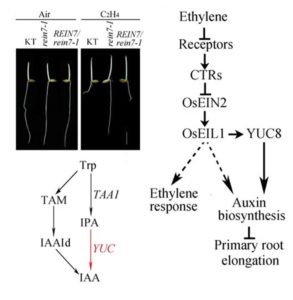 The role of crosstalk between auxin and ethylene in primary root development has been studied in the dicot model plant Arabidopsis thaliana, but is less well understood in monocots. Through a genetic screen for roots that elongate in the presence of ethylene , Qin, Zhang et al. identified a mutant rice ethylene insensitive (rein7-1). REIN7 corresponds to YUC8 (YUCCA8), an enzyme involved in the conversion of IPA (indole-3-pyruvic acid) to IAA (indole-3-acetic acid). Mutation of REIN7/YUC8 reduces auxin biosynthesis, and over expression of it induces ethylene sensitivity in root. Further genetic analysis showed that REIN7/YUC8 acts downstream of OsEIL1 and is transcriptionally activated by OsEIL1. The authors propose a model for how ethylene promotes auxin synthesis and inhibits rice root elongation. (Summary by Arif Ashraf) PLOS Genetics 10.1371/journal.pgen.1006955
The role of crosstalk between auxin and ethylene in primary root development has been studied in the dicot model plant Arabidopsis thaliana, but is less well understood in monocots. Through a genetic screen for roots that elongate in the presence of ethylene , Qin, Zhang et al. identified a mutant rice ethylene insensitive (rein7-1). REIN7 corresponds to YUC8 (YUCCA8), an enzyme involved in the conversion of IPA (indole-3-pyruvic acid) to IAA (indole-3-acetic acid). Mutation of REIN7/YUC8 reduces auxin biosynthesis, and over expression of it induces ethylene sensitivity in root. Further genetic analysis showed that REIN7/YUC8 acts downstream of OsEIL1 and is transcriptionally activated by OsEIL1. The authors propose a model for how ethylene promotes auxin synthesis and inhibits rice root elongation. (Summary by Arif Ashraf) PLOS Genetics 10.1371/journal.pgen.1006955
4D root gene expression
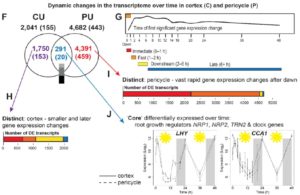 It becomes more and more clear that regulation of complex traits and processes, such as root growth and lateral root growth, involves not only gene expression quality (which genes are expressed), quantity (how much transcript is present) and space (in which cell-type transcripts are accumulating) but also time plays an important role. Walker et al. investigated root cell-type specific transcriptomic responses to external stimuli with a unique high-resolution time series. By coupling fluorescence-activated cell sorting (FACS) with microarray analysis, the authors were able to follow cortex and pericycle gene expression over 14 time points during 48 hours of treatments (nitrogen or rhizobia). Among the main results, they found out that individual transcripts are expressed with a very high degree of temporal and spatial specificity, but surprisingly biological processes are commonly regulated. Nevertheless some ‘core’ genes coordinate changes both in cortex and pericycle, mainly connected to circadian clock. The authors summarize, “This reinforces that the activity of a gene cannot be defined simply as molecular function; rather, it is a consequence of spatial location, expression timing and environmental responsiveness.” (Summary by Marco Giovannetti). Plant Cell 10.1105/tpc.16.00961
It becomes more and more clear that regulation of complex traits and processes, such as root growth and lateral root growth, involves not only gene expression quality (which genes are expressed), quantity (how much transcript is present) and space (in which cell-type transcripts are accumulating) but also time plays an important role. Walker et al. investigated root cell-type specific transcriptomic responses to external stimuli with a unique high-resolution time series. By coupling fluorescence-activated cell sorting (FACS) with microarray analysis, the authors were able to follow cortex and pericycle gene expression over 14 time points during 48 hours of treatments (nitrogen or rhizobia). Among the main results, they found out that individual transcripts are expressed with a very high degree of temporal and spatial specificity, but surprisingly biological processes are commonly regulated. Nevertheless some ‘core’ genes coordinate changes both in cortex and pericycle, mainly connected to circadian clock. The authors summarize, “This reinforces that the activity of a gene cannot be defined simply as molecular function; rather, it is a consequence of spatial location, expression timing and environmental responsiveness.” (Summary by Marco Giovannetti). Plant Cell 10.1105/tpc.16.00961
Seasonal regulation of petal number in Cardamine hirsute
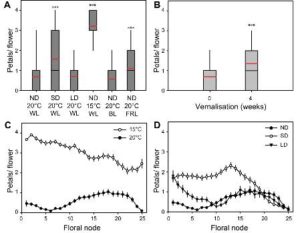 Flower development, unlike flowering timing, is a robust process not much affected by seasonal variation, such that the number of floral organs in each flower can be predicted quite precisely for different plant families. Most Brasiccaceae family species have flowers with fours petals, however, Cardamine hirsuta shows petal number variation at species, population and individual levels. Even though this variation is genetically determined, it is also influenced by environmental fluctuations. McKim et al. demonstrate that the number of petals produced in C. hirsuta flowers shows seasonal variation, with a complex underlying genetic mechanism. Petal number is increased by short days, simulated canopy shade and vernalization, with cool ambient temperatures showing the largest effect on this trait. More petals are produced in spring than in summer due to cooler temperatures, as floral primordium maturation time is extended. This allows floral meristems to grow for longer and at a slower rate, which in turn gives way to a wider inter-sepal region, which is positively correlated with increased number of petals. Petal number declines with ageing, an effect independent of SPL gene expression but correlated with a decline in sepal trichrome number. Although petal number is influenced by environmental cues that also affect flowering timing, the authors did not find co-variation of both traits. Plasticity in petal number could offer the opportunity for a flexible mating system in different conditions: fewer petals would lead to selfing, while more petals promote bud opening and might attract pollinators and outcrossing. (Summary by Gaby Auge) Plant Physiol. 10.1104/pp.17.00563
Flower development, unlike flowering timing, is a robust process not much affected by seasonal variation, such that the number of floral organs in each flower can be predicted quite precisely for different plant families. Most Brasiccaceae family species have flowers with fours petals, however, Cardamine hirsuta shows petal number variation at species, population and individual levels. Even though this variation is genetically determined, it is also influenced by environmental fluctuations. McKim et al. demonstrate that the number of petals produced in C. hirsuta flowers shows seasonal variation, with a complex underlying genetic mechanism. Petal number is increased by short days, simulated canopy shade and vernalization, with cool ambient temperatures showing the largest effect on this trait. More petals are produced in spring than in summer due to cooler temperatures, as floral primordium maturation time is extended. This allows floral meristems to grow for longer and at a slower rate, which in turn gives way to a wider inter-sepal region, which is positively correlated with increased number of petals. Petal number declines with ageing, an effect independent of SPL gene expression but correlated with a decline in sepal trichrome number. Although petal number is influenced by environmental cues that also affect flowering timing, the authors did not find co-variation of both traits. Plasticity in petal number could offer the opportunity for a flexible mating system in different conditions: fewer petals would lead to selfing, while more petals promote bud opening and might attract pollinators and outcrossing. (Summary by Gaby Auge) Plant Physiol. 10.1104/pp.17.00563
Phototropin perceives temperature based on the lifetime of its photoactivated state
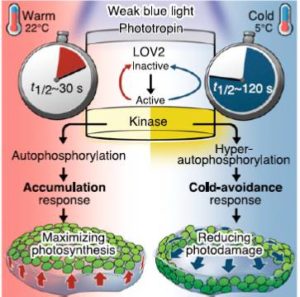 Fujii et al. studied the role that blue-light perceiving phototropins play in sensing temperature. They studied the temperature response in the liverwort Marchantia polymorpha, which has only one phototropin. At 5°C, blue-light perception by phototropins induces a cold-avoidance response in which chloroplasts move to the sides of the cells; by contrast at 22°C the chloroplasts spread out along the cell surface. This cold-avoidance response does not occur in a phototropin knockout suggesting the photoreceptor confers temperature sensing. The authors then undertook a series of experiments, including single cell analyses of temperature controlled blue light responses. They showed the half-life of the activated state of phototropin’s LOV2 domain is temperature dependent, which causes the temperature-sensitive chloroplast behavior. This study provides further evidence of light and temperature information being integrated in a single protein. (Summary by Ian Street) Proc. Natl. Acad. Sci. USA 10.1073/pnas.1704462114
Fujii et al. studied the role that blue-light perceiving phototropins play in sensing temperature. They studied the temperature response in the liverwort Marchantia polymorpha, which has only one phototropin. At 5°C, blue-light perception by phototropins induces a cold-avoidance response in which chloroplasts move to the sides of the cells; by contrast at 22°C the chloroplasts spread out along the cell surface. This cold-avoidance response does not occur in a phototropin knockout suggesting the photoreceptor confers temperature sensing. The authors then undertook a series of experiments, including single cell analyses of temperature controlled blue light responses. They showed the half-life of the activated state of phototropin’s LOV2 domain is temperature dependent, which causes the temperature-sensitive chloroplast behavior. This study provides further evidence of light and temperature information being integrated in a single protein. (Summary by Ian Street) Proc. Natl. Acad. Sci. USA 10.1073/pnas.1704462114
Artificial light at night as a new threat to pollination ($)
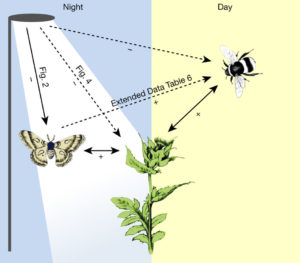 During our holidays, many of us plant scientists love to go to re-energize in remote places, ideally with no technology. Have you ever imagined how our “advanced” way of living is changing our environment? In a recent paper, Knop et al. show evidence that nocturnal pollinators are negatively affected by Artificial Light At Night and that consequences are observed on the success of plant reproduction; for example, in their study they showed a 62% reduction in pollinator visits and a 13% reduction in fruit set in artificial light at night conditions. This is big news if we consider the importance of pollination to wild and crop plants and the crucial service of these animals for global food supply. Although more experiments are needed, this study emphasizes the importance of studying global interacting communities and also the need for supporting plant science research. (Summary by Maria Julissa Ek Ramos). Nature 10.1038/nature23288.
During our holidays, many of us plant scientists love to go to re-energize in remote places, ideally with no technology. Have you ever imagined how our “advanced” way of living is changing our environment? In a recent paper, Knop et al. show evidence that nocturnal pollinators are negatively affected by Artificial Light At Night and that consequences are observed on the success of plant reproduction; for example, in their study they showed a 62% reduction in pollinator visits and a 13% reduction in fruit set in artificial light at night conditions. This is big news if we consider the importance of pollination to wild and crop plants and the crucial service of these animals for global food supply. Although more experiments are needed, this study emphasizes the importance of studying global interacting communities and also the need for supporting plant science research. (Summary by Maria Julissa Ek Ramos). Nature 10.1038/nature23288.
A worldwide-scale relationship between leaf size and climate ($)
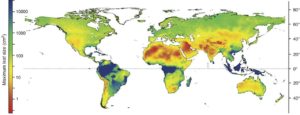 Leaf size varies by over 100,000-fold across the plant kingdom. Leaf area has a direct impact on tissue temperature and thus directly affects photosynthetic efficiency. Empirical observations by 19th century plant geographers described that larger leaves are usually restricted to plants growing in wet tropics; nevertheless environmental factors driving leaf size haven’t been studied at a global scale. This elegant study by Wright et al. provides a worldwide-scale quantification of how climatic drivers such as temperature, irradiance and moisture impact leaf size. The authors compiled leaf size datasets for more than 7,600 plant species sampled from hundreds of locations worldwide. Leaf size patterns were then compared to climatic variables. The analysis revealed that plant species harboring large leaves are usually located in hot and humid areas with high irradiance, while small-leaves-species are separated in two distinct climatic regions: hot and sunny arid regions as well as high altitude, high latitude areas. Based on these observations, the authors provide a model incorporating geographical limits to leaf size and revealing that day and night leaf-to-air temperature variation drive geographic gradients in leaf size. These data provide an important contribution towards designing better models on the consequence of climate change on vegetation. (Summary by Matthias Benoit) Science 10.1126/science.aal4760
Leaf size varies by over 100,000-fold across the plant kingdom. Leaf area has a direct impact on tissue temperature and thus directly affects photosynthetic efficiency. Empirical observations by 19th century plant geographers described that larger leaves are usually restricted to plants growing in wet tropics; nevertheless environmental factors driving leaf size haven’t been studied at a global scale. This elegant study by Wright et al. provides a worldwide-scale quantification of how climatic drivers such as temperature, irradiance and moisture impact leaf size. The authors compiled leaf size datasets for more than 7,600 plant species sampled from hundreds of locations worldwide. Leaf size patterns were then compared to climatic variables. The analysis revealed that plant species harboring large leaves are usually located in hot and humid areas with high irradiance, while small-leaves-species are separated in two distinct climatic regions: hot and sunny arid regions as well as high altitude, high latitude areas. Based on these observations, the authors provide a model incorporating geographical limits to leaf size and revealing that day and night leaf-to-air temperature variation drive geographic gradients in leaf size. These data provide an important contribution towards designing better models on the consequence of climate change on vegetation. (Summary by Matthias Benoit) Science 10.1126/science.aal4760
A multi-species synthesis of physiological mechanisms in drought-induced tree mortality
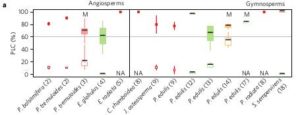 Global change forecasts include projections of severe droughts that could affect many forested biomes, largely influencing future energy and element fluxes. There are two physiological mechanisms associated with tree mortality in response to drought: hydraulic failure (inhibition of water transport) and carbon starvation (imbalance between carbon demand and supply). Adams et al. studied the prevalence or co-occurrence of these mechanisms at a global scale in drought-induced tree mortality by using a standardized physiological framework across species and assessing data from recent studies of percentage loss of xylem conductivity (PLC) and in-tissue non-structural carbohydrates (NSC). Their results show that tree mortality is universally associated with loss of hydraulic function (increased PLC) and is sometimes related to reduced NSC. Determining whether the co-occurrence of increased PLC and reduced NSC are facilitating death or a result of the mortality process requires more empirical work. Furthermore, knowledge of the physiological mechanisms underlying the mortality process, and the intensity and duration of drought needed to start tree death, is scarce and needed. Altogether, a better framework for developing mechanistic models is needed to more accurately predict future global carbon budgets. (Summary by Gaby Auge) Nature Ecol. Evol. 10.1038/s41559-017-0248-x
Global change forecasts include projections of severe droughts that could affect many forested biomes, largely influencing future energy and element fluxes. There are two physiological mechanisms associated with tree mortality in response to drought: hydraulic failure (inhibition of water transport) and carbon starvation (imbalance between carbon demand and supply). Adams et al. studied the prevalence or co-occurrence of these mechanisms at a global scale in drought-induced tree mortality by using a standardized physiological framework across species and assessing data from recent studies of percentage loss of xylem conductivity (PLC) and in-tissue non-structural carbohydrates (NSC). Their results show that tree mortality is universally associated with loss of hydraulic function (increased PLC) and is sometimes related to reduced NSC. Determining whether the co-occurrence of increased PLC and reduced NSC are facilitating death or a result of the mortality process requires more empirical work. Furthermore, knowledge of the physiological mechanisms underlying the mortality process, and the intensity and duration of drought needed to start tree death, is scarce and needed. Altogether, a better framework for developing mechanistic models is needed to more accurately predict future global carbon budgets. (Summary by Gaby Auge) Nature Ecol. Evol. 10.1038/s41559-017-0248-x



